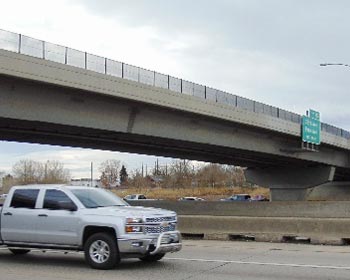

Research Reports |
| Title: | Seismic Behavior of Steel Bridges with Fatigue-Prone Details |
| Authors: | Hussam Mahmoud, Mazin Irfaee, and Emad Hassan |
| University: | Colorado State University |
| Publication Date: | Sep 2018 |
| Report #: | MPC-18-368 |
| Project #: | MPC-382 |
| TRID #: | 01710548 |
| Keywords: | bridge superstructures, cracking, dislocation (geology), earthquake resistant design, fatigue (mechanics), finite element method, girder bridges, reinforced concrete, seismicity, steel bridges |
| Type: | Research Report – MPC Publications |
 Steel bridges with reinforced concrete substructures and steel superstructures are considered to have superior performance under earthquakes when compared with their reinforced concrete counterpart. Such performance reputation stems from the fact that few steel bridges have been subjected to strong ground motion in the last decade in North America. In addition to the lack of seismic exposure of bridges, research on the seismic performance of steel bridges' superstructure is limited to handful of studies. It is noteworthy that none of the previously conducted studies addressed the behavior of the bridge superstructure's fatigue details, which are designed for traffic loading, under earthquake loading. The studies also did not address the potential for the presence of existing cracks in bridges when an earthquake occurs. In the superstructure, fatigue is often the most prevalent problem in steel bridges and contributes to approximately 90% of existing cracks. The cracks are a result of the repeated traffic cycles exerted on the bridge, which is a primary concern in older bridges. In this study, the seismic behavior of a twin tub steel girder bridge is evaluated. Specifically, a detailed finite element model of the bridge in question is developed, and the model is subjected to a suite of ground motions. Of the two models developed, one did not include any initial cracks and one included a crack that presumably developed because of fatigue loading from usual traffic. The results of the analysis show large displacement of the bridge due to exposure to some of the earthquakes. In addition, the results show the potential for developing low cycle fatigue failure in some of the details, even in the absence of an initial crack. These results are critical as they highlight the importance for detailed assessment of the superstructure for bridges in moderate to high seismic regions.
Steel bridges with reinforced concrete substructures and steel superstructures are considered to have superior performance under earthquakes when compared with their reinforced concrete counterpart. Such performance reputation stems from the fact that few steel bridges have been subjected to strong ground motion in the last decade in North America. In addition to the lack of seismic exposure of bridges, research on the seismic performance of steel bridges' superstructure is limited to handful of studies. It is noteworthy that none of the previously conducted studies addressed the behavior of the bridge superstructure's fatigue details, which are designed for traffic loading, under earthquake loading. The studies also did not address the potential for the presence of existing cracks in bridges when an earthquake occurs. In the superstructure, fatigue is often the most prevalent problem in steel bridges and contributes to approximately 90% of existing cracks. The cracks are a result of the repeated traffic cycles exerted on the bridge, which is a primary concern in older bridges. In this study, the seismic behavior of a twin tub steel girder bridge is evaluated. Specifically, a detailed finite element model of the bridge in question is developed, and the model is subjected to a suite of ground motions. Of the two models developed, one did not include any initial cracks and one included a crack that presumably developed because of fatigue loading from usual traffic. The results of the analysis show large displacement of the bridge due to exposure to some of the earthquakes. In addition, the results show the potential for developing low cycle fatigue failure in some of the details, even in the absence of an initial crack. These results are critical as they highlight the importance for detailed assessment of the superstructure for bridges in moderate to high seismic regions.
Mahmoud, Hussam, Mazin Irfaee, and Emad Hassan. Seismic Behavior of Steel Bridges with Fatigue-Prone Details, MPC-18-368. North Dakota State University - Upper Great Plains Transportation Institute, Fargo: Mountain-Plains Consortium, 2018.